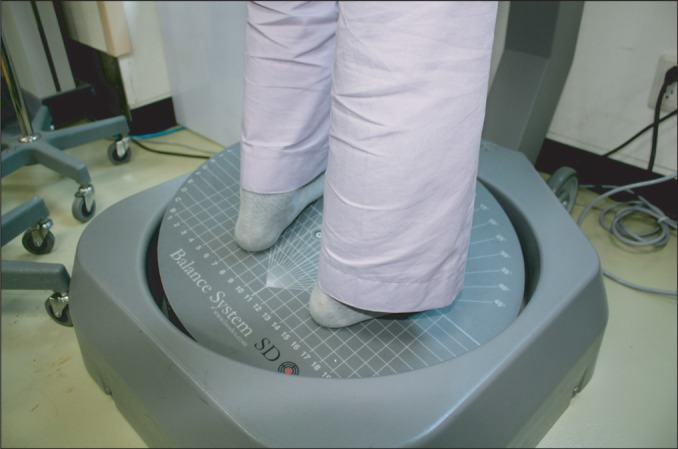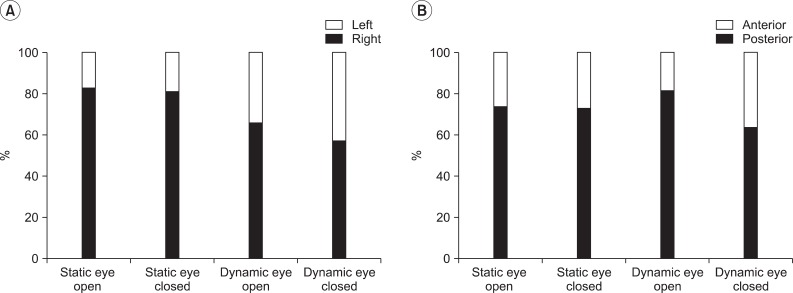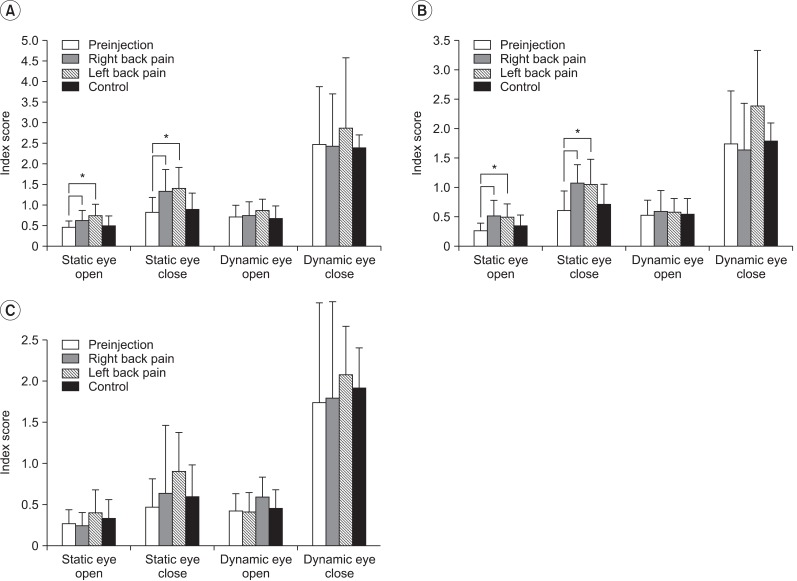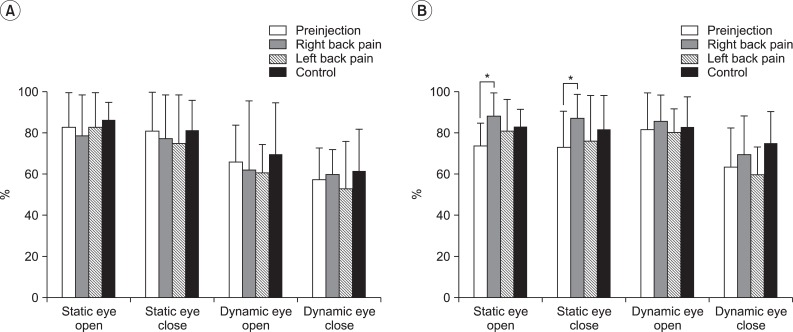Ann Rehabil Med.
2013 Feb;37(1):17-25. 10.5535/arm.2013.37.1.17.
Effects of Acute Low Back Pain on Postural Control
- Affiliations
-
- 1Department of Rehabilitation Medicine, Chungnam National University School of Medicine, Daejeon, Korea. smfahen@cnuh.co.kr
- KMID: 2266646
- DOI: http://doi.org/10.5535/arm.2013.37.1.17
Abstract
OBJECTIVE
To evaluate the changes in static and dynamic postural control after the development of acute low back pain.
METHODS
Thirty healthy right-handed volunteers were divided into three groups; the right back pain group, the left back pain group, and the control group. 0.5 mL of 5% hypertonic saline was injected into L4-5 paraspinal muscle for 5 seconds to cause muscle pain. The movement of the center of gravity (COG) during their static and dynamic postural control was measured with their eyes open and with their eyes closed before and 2 minutes after the injection.
RESULTS
The COGs for the healthy adults shifted to the right quadrant and the posterior quadrant during their static and dynamic postural control test (p<0.05). The static and dynamic instability index while they had their eyes closed was significantly increased than when they had their eyes open with and without acute back pain. After pain induction, their overall and anterior/posterior instability was increased in both the right back pain group and the left back pain group during the static postural control test (p<0.05). A right deviation and a posterior deviation of the COG still remained, and the posterior deviation was greater in the right back pain group (p<0.05).
CONCLUSION
The static instability, particularly the anterior/posterior instability was increased in the presence of acute low back pain, regardless of the visual information and the location of pain.
Keyword
Figure
Cited by 2 articles
-
The Effects of Shoulder Slings on Balance in Patients With Hemiplegic Stroke
Min Kyun Sohn, Sung Ju Jee, Pyoungsik Hwang, Yumi Jeon, Hyunkeun Lee
Ann Rehabil Med. 2015;39(6):986-994. doi: 10.5535/arm.2015.39.6.986.Effect of Whole Body Horizontal Vibration Exercise in Chronic Low Back Pain Patients: Vertical Versus Horizontal Vibration Exercise
Heejae Kim, Bum Sun Kwon, Jin-Woo Park, Hojun Lee, Kiyeun Nam, Taejune Park, Yongjin Cho, Taeyeon Kim
Ann Rehabil Med. 2018;42(6):804-813. doi: 10.5535/arm.2018.42.6.804.
Reference
-
1. Prado JM, Stoffregen TA, Duarte M. Postural sway during dual tasks in young and elderly adults. Gerontology. 2007; 53:274–281. PMID: 17510558.
Article2. Nashner LM. Duncan PW, editor. Sensory, neuromuscular, and biomechanical contributions to human balance. Balance: proceedings of the APTA Forum; 1989 Jun 13-15; Nashville, TN. 1990. Alexandria, VA: American Physical Therapy Association.3. Newcomer KL, Laskowski ER, Yu B, Johnson JC, An KN. Differences in repositioning error among patients with low back pain compared with control subjects. Spine (Phila Pa 1976). 2000; 25:2488–2493. PMID: 11013501.
Article4. Laskowski ER, Newcomer-Aney K, Smith J. Proprioception. Phys Med Rehabil Clin N Am. 2000; 11:323–340. PMID: 10810764.
Article5. Mok NW, Brauer SG, Hodges PW. Changes in lumbar movement in people with low back pain are related to compromised balance. Spine (Phila Pa 1976). 2011; 36:E45–E52. PMID: 21192214.
Article6. Nies N, Sinnott PL. Variations in balance and body sway in middle-aged adults: subjects with healthy backs compared with subjects with low-back dysfunction. Spine (Phila Pa 1976). 1991; 16:325–330. PMID: 1827539.7. Mientjes MI, Frank JS. Balance in chronic low back pain patients compared to healthy people under various conditions in upright standing. Clin Biomech (Bristol, Avon). 1999; 14:710–716.
Article8. Hodges PW, Richardson CA. Delayed postural contraction of transverses abdominis in low back pain associated with movement of the lower limb. J Spinal Disord. 1998; 11:46–56. PMID: 9493770.9. Radebold A, Cholewicki J, Polzhofer GK, Greene HS. Impaired postural control of the lumbar spine is associated with delayed muscle response times in patients with chronic idiopathic low back pain. Spine (Phila Pa 1976). 2001; 26:724–730. PMID: 11295888.
Article10. Zedka M, Prochazka A, Knight B, Gillard D, Gauthier M. Voluntary and reflex control of human back muscles during induced pain. J Physiol. 1999; 520(Pt 2):591–604. PMID: 10523425.
Article11. Hodges PW, Moseley GL, Gabrielsson A, Gandevia SC. Experimental muscle pain changes feedforward postural responses of the trunk muscles. Exp Brain Res. 2003; 151:262–271. PMID: 12783146.
Article12. Boudreau S, Farina D, Kongstad L, Buus D, Redder J, Sverrisdottir E, et al. The relative timing of trunk muscle activation is retained in response to unanticipated postural-perturbations during acute low back pain. Exp Brain Res. 2011; 210:259–267. PMID: 21442223.
Article13. Notzel D, Puta C, Wagner H, Anders C, Petrovich A, Gabriel HH. Altered hip muscle activation in patients with chronic non-specific low back pain. Schmerz. 2011; 25:199–206. PMID: 21424336.14. Jacobs JV, Henry SM, Jones SL, Hitt JR, Bunn JY. A history of low back pain associates with altered electromyographic activation patterns in response to perturbations of standing balance. J Neurophysiol. 2011; 106:2506–2514. PMID: 21795622.
Article15. Cachupe WJ, Shifflett B, Kahanov L, Wughalter EH. Reliability of Biodex Balance System Measures. Meas Phys Educ Exerc Sci. 2001; 5:97–108.
Article16. Inglis JT, Horak FB, Shupert CL, Jones-Rycewicz C. The importance of somatosensory information in triggering and scaling automatic postural responses in humans. Exp Brain Res. 1994; 101:159–164. PMID: 7843295.
Article17. Kantor E, Poupard L, Le Bozec S, Bouisset S. Does body stability depend on postural chain mobility or stability area? Neurosci Lett. 2001; 308:128–132. PMID: 11457576.
Article18. Hodges PW, Gurfinkel VS, Brumagne S, Smith TC, Cordo PC. Coexistence of stability and mobility in postural control: evidence from postural compensation for respiration. Exp Brain Res. 2002; 144:293–302. PMID: 12021811.
Article19. Horak FB, Nashner LM. Central programming of postural movements: adaptation to altered support-surface configurations. J Neurophysiol. 1986; 55:1369–1381. PMID: 3734861.
Article20. Magni G, Caldieron C, Rigatti-Luchini S, Merskey H. Chronic musculoskeletal pain and depressive symptoms in the general population: an analysis of the 1st National Health and Nutrition Examination Survey data. Pain. 1990; 43:299–307. PMID: 2293141.
Article21. Leinonen V, Kankaanpaa M, Luukkonen M, Kansanen M, Hanninen O, Airaksinen O, et al. Lumbar paraspinal muscle function, perception of lumbar position, and postural control in disc herniation-related back pain. Spine (Phila Pa 1976). 2003; 28:842–848. PMID: 12698130.
Article22. Sohn MK, Yoon YS, Jun KH. EMG power spectrum of lumbar back muscle in chronic low back pain patients. J Korean Acad Rehabil Med. 1998; 22:68–76.23. Pandy MG, Lin YC, Kim HJ. Muscle coordination of mediolateral balance in normal walking. J Biomech. 2010; 43:2055–2064. PMID: 20451911.
Article24. Nelson-Wong E, Howarth SJ, Callaghan JP. Acute biomechanical responses to a prolonged standing exposure in a simulated occupational setting. Ergonomics. 2010; 53:1117–1128. PMID: 20737337.
Article25. della Volpe R, Popa T, Ginanneschi F, Spidalieri R, Mazzocchio R, Rossi A. Changes in coordination of postural control during dynamic stance in chronic low back pain patients. Gait Posture. 2006; 24:349–355. PMID: 16311036.
Article26. Krause DA, Jacobs RS, Pilger KE, Sather BR, Sibunka SP, Hollman JH. Electromyographic analysis of the gluteus medius in five weight-bearing exercises. J Strength Cond Res. 2009; 23:2689–2694. PMID: 19910807.
Article27. Clark BC, Manini TM, Mayer JM, Ploutz-Snyder LL, Graves JE. Electromyographic activity of the lumbar and hip extensors during dynamic trunk extension exercise. Arch Phys Med Rehabil. 2002; 83:1547–1552. PMID: 12422323.
Article28. Lim KB, Lee HJ, Joo SJ, Lim SS. Postural control measures of patients with lower back pain using balance master system. J Korean Acad Rehabil Med. 2007; 31:30–36.
- Full Text Links
- Actions
-
Cited
- CITED
-
- Close
- Share
- Similar articles
-
- Postural Control Measures of Patients with Lower Back Pain Using Balance Master(R) System
- Balance Ability in Low Back Pain Patients With Lumbosacral Radiculopathy Evaluated With Tetrax: A Matched Case-Control Study
- Lumbar Disc Screening Using Back Pain Questionnaires: Oswestry Low Back Pain Score, Aberdeen Low Back Pain Scale, and Acute Low Back Pain Screening Questionnaire
- Rating Scale for Low Back Pain
- Effects of a Strengthening Program for Lower Back in Older Women with Chronic Low Back Pain







